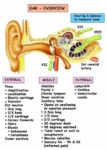The human skeleton is a complex structure that serves as the framework for the body, providing support, protection, and enabling motion. It consists of many individual bones and cartilages, along with bands of fibrous connective tissue known as ligaments and tendons.
The skeleton is divided into two principal subdivisions:
1. Axial Skeleton: This includes the vertebral column (spine), much of the skull, and the visceral skeleton, which comprises the lower jaw, some elements of the upper jaw, and the branchial arches, including the hyoid bone.
2. Appendicular Skeleton: This includes the pelvic (hip) and pectoral (shoulder) girdles, and the bones and cartilages of the limbs.
Axial Skeleton
– Skull: Composed of 22 bones that are fused together except for the mandible. These bones protect the brain and support the eyes, nose, and mouth.
– Vertebral Column: Made up of 26 vertebrae, including 7 cervical (neck), 12 thoracic (chest), 5 lumbar (lower back), 1 sacrum, and 1 coccyx (tailbone). It provides the main support for the trunk.
Appendicular Skeleton
– Upper and Lower Limbs: These include all the bones of the arms and legs.
– Pelvic Girdle: This is the structure to which the lower limbs attach.
– Pectoral Girdle: This is the structure to which the upper limbs attach.
The skeleton also has several other crucial functions:
– Support: The skeleton provides the framework that supports the body and maintains its shape.
– Protection: The skeleton protects the body’s internal organs. For example, the skull protects the brain, and the rib cage protects the heart and lungs.
– Movement: Bones provide the structure for muscles to attach. When muscles contract, they pull on bones, which act as levers to create movement.
– Mineral Storage: Bones act as the bodys warehouse for calcium, iron, and energy in the form of fat.
– Blood Cell Production: New blood cells are produced by the red bone marrow inside our bones.
In conclusion, the human skeleton is a marvel of biological engineering, providing support, protection, and facilitating movement, among other functions. Its complexity and efficiency underscore its importance in human anatomy and physiology..



